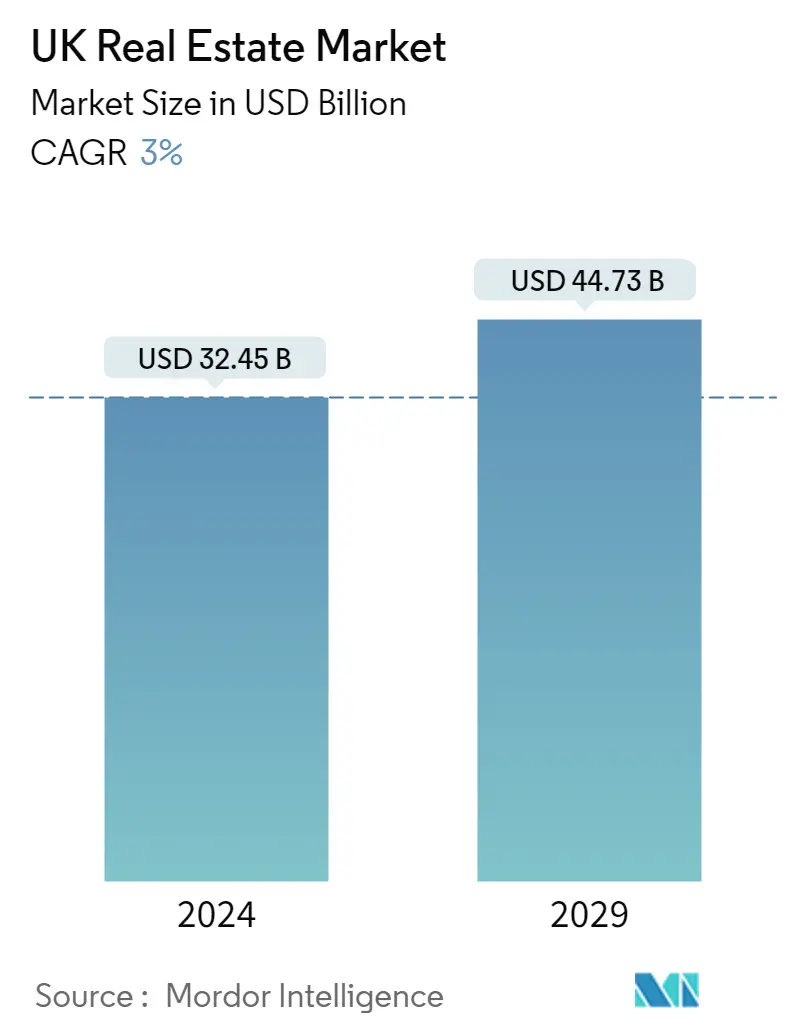Market Size of UK Real Estate Industry

| Study Period | 2020 - 2029 |
| Base Year For Estimation | 2023 |
| Market Size (2024) | USD 32.45 Billion |
| Market Size (2029) | USD 44.73 Billion |
| CAGR (2024 - 2029) | 3.00 % |
| Market Concentration | Low |
Major Players_-_Copy.webp)
*Disclaimer: Major Players sorted in no particular order |
UK Real Estate Services Market Analysis
The UK Real Estate Market size is estimated at USD 32.45 billion in 2024, and is expected to reach USD 44.73 billion by 2029, growing at a CAGR of 3% during the forecast period (2024-2029).
A large proportion of office workers have started working from home. As a result, many companies have had to rethink their office models and embrace hybrid work. In 2023, there was an increase in office space vacancies across the majority of UK city centers compared to the pre-pandemic period.
The UK economy is projected to grow at a slower rate in 2023 than it did in 2022. A weak economy could result in fewer jobs and lower consumer confidence, which could hurt house prices. According to the International Monetary Fund, the UK economy is expected to grow at a 0.3% annual rate in 2023 before expanding by 1% in the following year.
The UK real estate market has gone through many cycles of boom and bust. Over the years, it has been a relatively stable market for homeowners and investors. House prices tend to increase over a long period. However, there has also been a lot of volatility in the market, with prices falling off a cliff during an economic recession or a housing bubble.
Interest rates have been repeatedly increased by the Bank of England in 2022, and the market expects small increases in 2023. Higher borrowing costs push down house prices. The BoE has reported that variable mortgage rates have almost doubled over the past year.
UK Real Estate Services Industry Segmentation
Real estate services mean providing a service concerning the purchase, sale, lease, rental, or appraisal of real property.
The report provides a comprehensive background analysis of the United Kingdom real estate services market, covering the current market trends, restraints, technological updates, and detailed information on various segments and the competitive landscape of the industry. Additionally, the COVID-19 impact has been incorporated and considered during the study.
The UK real estate services market is segmented by property type (residential, commercial, and other property types) and service (property management, valuation services, and other services). The report offers market size and forecasts in value (USD) for all the above segments.
| Property type | |
| Residential | |
| Commercial | |
| Other Property Types |
| Service | |
| Property Management | |
| Valuation | |
| Other Services |
UK Real Estate Market Size Summary
The UK real estate market is experiencing a period of transformation, influenced by shifts in work patterns and economic conditions. The rise of hybrid work models has led to increased office space vacancies in urban centers, prompting companies to reevaluate their office needs. Despite these challenges, the market remains relatively stable, with house prices generally trending upward over the long term, although they are subject to volatility during economic downturns or housing bubbles. The market is also impacted by factors such as interest rates, which have been on the rise, leading to higher borrowing costs and potentially dampening house prices. The supply-demand dynamics play a crucial role, with a lack of housing supply driving up prices, particularly in competitive areas like London, where average house prices are significantly higher than the national average.
The UK real estate services sector is characterized by a fragmented landscape with both international and local players, including prominent firms like Knight Frank, Savills Ltd, and regional entities such as Atalian Servest Ltd and Notting Hill Genesis. The market is currently facing a slowdown in transactions due to rising mortgage rates and a cost of living crisis, which has curtailed the previous trend of significant price growth. However, there is a growing demand for residential and rental properties, driven by increased remote work and a desire for larger homes, especially in suburban areas. The shortage of quality rental homes has attracted investor interest in purpose-built rental properties, particularly in city centers, as the market adapts to evolving living and working preferences.
UK Real Estate Market Size - Table of Contents
-
1. MARKET INSIGHTS
-
1.1 Current Economic Scenario
-
1.2 Real Estate Buying Trends - Socioeconomic and Demographic Insights
-
1.3 Government Initiatives and Regulatory Aspects for Real Estate Sector
-
1.4 Insights into Existing and Upcoming Projects
-
1.5 Insight into Interest Rate Regime for General Economy and Real Estate Lending
-
1.6 Insights into Capital Market Penetration and REIT Presence in Real Estate
-
1.7 Insights into Rental Yields in Real Estate Segment
-
1.8 Insights into Public-Private Partnerships in Real Estate
-
1.9 Insights into Real Estate Tech and Startups Active in Real Estate Segment (Brokerage, Social Media, Facility Management, and Property Management)
-
1.10 Impact of COVID-19 on the Market
-
-
2. MARKET SEGMENTATION
-
2.1 Property type
-
2.1.1 Residential
-
2.1.2 Commercial
-
2.1.3 Other Property Types
-
-
2.2 Service
-
2.2.1 Property Management
-
2.2.2 Valuation
-
2.2.3 Other Services
-
-
UK Real Estate Market Size FAQs
How big is the UK Real Estate Market?
The UK Real Estate Market size is expected to reach USD 32.45 billion in 2024 and grow at a CAGR of 3% to reach USD 44.73 billion by 2029.
What is the current UK Real Estate Market size?
In 2024, the UK Real Estate Market size is expected to reach USD 32.45 billion.

